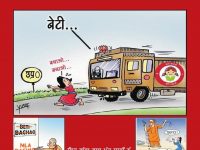B. Pradeep
The RTC workers strike in Telangana that began on 5th October ended with the Chief Minister, KCR, declaring that there would be no privatization, that there will be no victimization and that wages for the month of September and for the strike period will be paid. While the JAC of the unions had formally called off the strike on 25th November, workers were not allowed to join work till the CM announced the above in a meeting in his Pragati Bhavan on December 1st with five representatives each from the 97 depots, thus bypassing the JAC of the unions. This 52 days long strike of the RTC workers was the longest one in the history of transport workers struggles in the state. It has exposed the despicable role of the state government in dealing with the legitimate struggle of the RTC workers. The strike has thrown up questions and challenges that need to be addressed by the working class movement at large.
After the bifurcation of AP, Telangana state RTC has a workforce of around 50,000 with 97 depots and over 10,000 buses. Its assets are valued at Rs. sixty thousand crores. Wage revision was due from 2017 and the JAC of the unions put forth some 26 demands among which one was the merger of the corporation in the government as was done in the neighbouring state of AP. While there was no progress in the negotiations due to the negative stance of the management and the government, discontent was brewing and pressure on the unions leaders began mounting. The issues were before the concerned ‘authority’ at the labour office and joint meetings were held but to no avail. In this backdrop, the JAC of the unions served strike notice and the legitimate strike began on 5th October, which was close to the Dasara festival season when people commute to their native places.
The entire RTC was completely shut down from day one and the CM of the state issued a warning that if workers did not report to duties by 6th night, they would be deemed dismissed or what he foolishly called “self dismissed”. None bowed to this warning and the strike continued. Again after a month the CM set a deadline, 5th November, by which time workers should report to duty, otherwise there would be no RTC and that it would be privatized. This warning also failed in forcing the workers to break the strike. The way in which the KCR government was dealing with this successful strike was despicable and can be likened to a feudal lord responding to the unrest of his subjects. During this period the CM made several statements that reflected the utter arrogance of a lord in question who issues threats to force the subjects into submission. He issued a warning that none can save the RTC now’, that the government cannot pay September month’s salary as it does not have money, that the state cabinet decided to handover 5100 buses to private players etc. Such irresponsible and unilateral statements by the CM played their own role in pushing some workers to committing suicides and some dying of heart attacks. In all some 38 workers died during this period.children’. The striking workers nurtured some hopes and were expecting that the court would come to their rescue in the face of the negative and dictatorial stance of the government. But the final outcome in the Court was disappointing as it said it cannot do much in the issue and in regard to the cabinets decision to privatize certain routes. In fact it made comments on the supposed virtues of privatization.
In the strike period the role of the High Court also needs to be assessed. In the initial period, responding to petitions pending before it, it advised the government to negotiate with the union and resolve the problems as people are facing immense hardships due to the strike. It said that the government should act as a ‘model employer’ and treat the employees as
As far as the strike proper is concerned, there can be no two opinions that workers participation in it was almost total. The workers stood ground in the face of threats from the government. They struck work but at the same time could not stop buses driven by drivers on contract. This task was left to the organizations supporting the strike. A series of programmes were taken up during the strike period at the local levels that saw good participation. Two major programmes were held in Hyderabad in which the participation was commendable. Some thirty thousand turned up for the public meeting held on 29 October despite restrictions imposed by the police. The chalo ‘Tank Bund’ programme on 10 November was also a success with workers breaking police cordons and marching on the bund and facing the lathis & teargas shells. Many workers were injured in police violence. Prior to this programme, on 19 October a state bandh was called with the help of mass organizations & political parties. It was during this bandh that Ranga Rao, Asst. Secretary of CPI(ML)-New Democracy in Telangana state, sustained injury on his thumb.
The strike reached a point where it had to either move to a higher level by way of active support from different sections of people in the face of the governments adamantly negative position or make an honourable retreat. The few buses that were plying needed to be stopped.The strike needed the support of the government employees which did not happen. When KCR was making statements against the very notion of workers unions, against trade unions in the RTC, different sections of the working class should have come out on the streets which did not happen.The workers of different sectors,particularly in the government sector, need to realise that their failure to rise in support of this strike was a contributing factor in pushing the strike to a defensive position. These short comings apart, there were some illusions that the Court would come to the rescue of workers and that some relief would come out which did not. Pinning hopes on the Central government and the BJP here proved to be entirely wrong.
Despite these shortcomings and weaknesses of the 52 days RTC workers strike, it was a successful one with a wonderful show of unity of the workers inspite of all the hurdles erected by the government.


